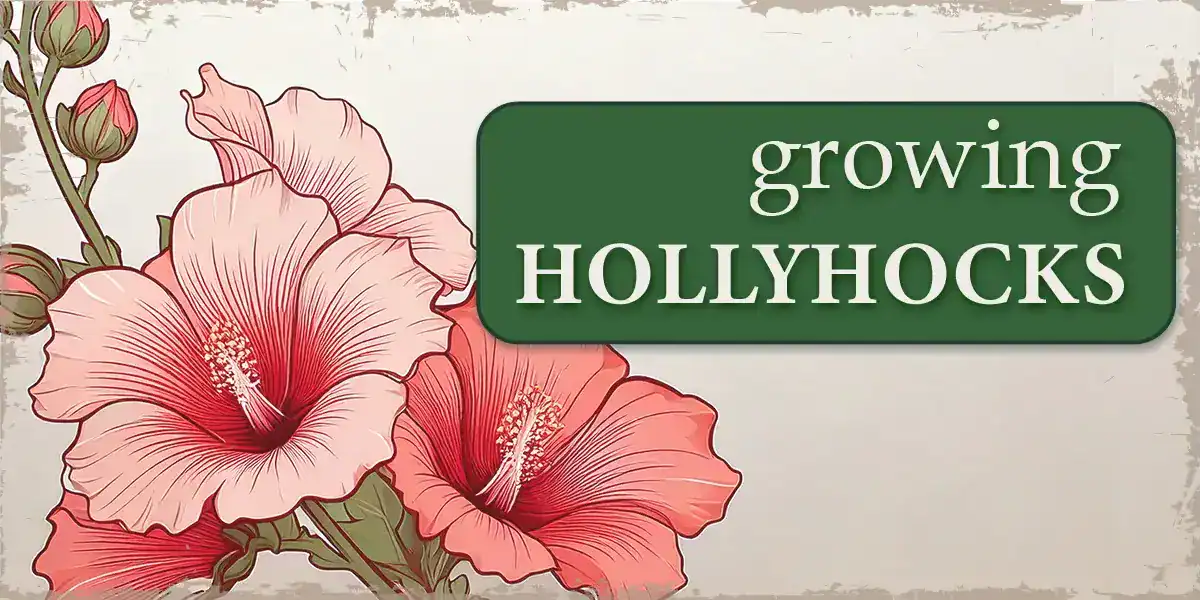Humans and hollyhocks go way back.
Archaeologists have discovered hollyhock pollen in Neanderthal burial sites in Iraq, suggesting it had spiritual or medicinal importance as early as 50,000 years ago.
Sumerian clay tablets mention plants with large, showy blooms, which many scholars believe refers to hollyhocks.
Colonial American apothecaries used hollyhock root and leaves in salves for burns and skin irritations, especially when marshmallow root wasn’t available.
And in the 19th century, the “language of flowers” (floriography) was wildly popular. Hollyhocks symbolized ambition and fruitfulness. A gift of hollyhocks carried the subtle message: “Rise to greatness.” Their towering growth habit likely contributed to this symbolism.
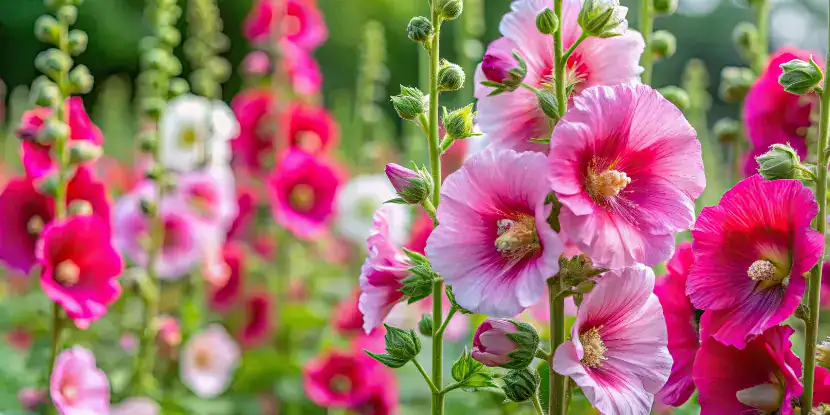
Flowering hollyhocks in a field.
Origins of Hollyhocks
Hollyhocks (Alcea rosea) were first cultivated for medicine in Asia and the Middle East. Over the centuries, they became a favorite ornamental plant across European cottage gardens, eventually earning their place in gardens worldwide.
The plants are typically biennials, meaning they grow foliage in their first year and bloom in their second. However, in favorable conditions, many hollyhocks act more like perennials, returning year after year.
Their tall spikes can rise to 6–8 feet and are adorned with large, funnel-shaped flowers in colors ranging from soft pastels to bright jewel tones.
Dwarf hollyhock varieties reach only 2–3 feet tall and are often better suited for smaller garden spaces.
All hollyhocks, regardless of size, will draw pollinators to your garden.
Propagating Hollyhocks
Hollyhocks can be propagated from seeds or cuttings. Seeds are the easiest and most common method.
- Timing: Sow seeds in late summer or fall for spring blooms.
- Placement: Scatter seeds directly into well-prepared soil, about 1–2 feet apart.
- Depth: Cover them lightly with no more than ¼ inch deep soil.
- Watering: Keep the soil moist until seedlings emerge in 10–14 days.
Established hollyhocks will often reseed themselves, maintaining your garden’s display with minimal effort.
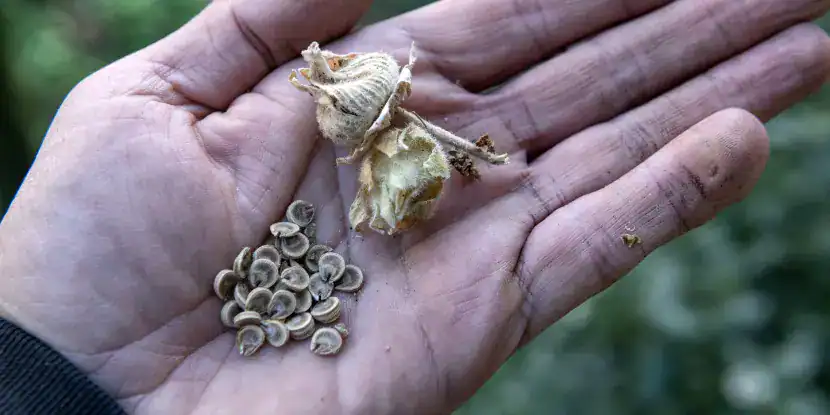
Hollyhocks seeds ready for planting.
Optimal Growing Conditions
Light
Hollyhocks love full sun and need at least 6–8 hours of direct sunlight daily. Select a sunny location to ensure vigorous growth and abundant flowering.
Temperature
These flowers are heat-loving and can easily handle LA’s scorching summer days. However, they also tolerate cool, mild winters, making them a perfect year-round choice for the region.
Soil
- Hollyhocks prefer well-draining, moderately rich soil.
- Prepare the soil by adding organic compost, which improves drainage and provides nutrients.
- Avoid heavy, clay-like soil that retains too much water.

Vibrant red hollyhock blossoms.
Steps for Planting
- Loosen the top 12 inches of soil and work in compost or organic matter.
- Space seeds or transplants about 1–2 feet apart to allow room for growth.
- Sow seeds directly into the soil or plant nursery-bought hollyhock starters.
- Water newly planted seeds or transplants regularly until they’re well established.
- Use stakes or plant hollyhocks along fences to support their tall stems.
Caring for Hollyhocks
Water
Hollyhocks are drought-tolerant, but they do best with occasional deep watering. Water once per week during dry months, and never waterlog the soil.
Fertilizer
Feed hollyhocks with a balanced, slow-release fertilizer at the start of the growing season. Avoid over-fertilizing, which can lead to excess foliage at the expense of flowers.
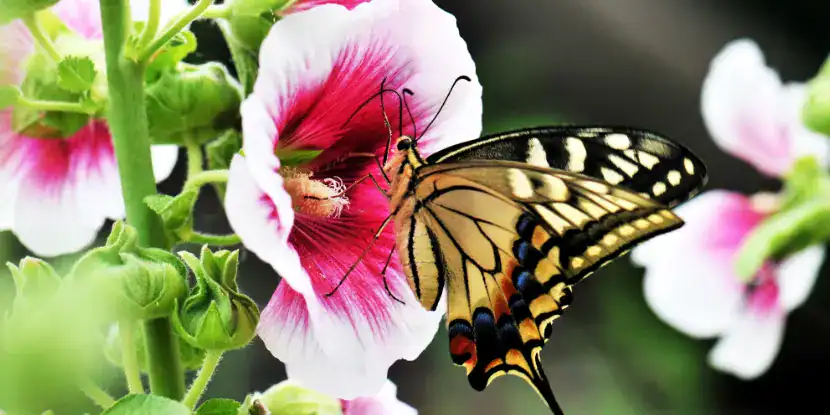
Hollyhock flowers are sure to attract pollinators like bees, butterflies, and hummingbirds.
Pests & Diseases
Rust (a fungal disease) or pests like aphids can sometimes affect hollyhocks.
- Remove infected leaves and improve air circulation to prevent rust.
- Spray plants with neem oil or insecticidal soap to control aphids.
Pruning
Deadhead spent blooms to encourage continuous flowering. At the end of the season, cut back stems to tidy up your garden and promote healthy regrowth.
Replanting & Reseeding
Hollyhocks reseed themselves naturally. Allow some flowers to go to seed, and they’ll replenish your garden each season. If starting fresh, collect seeds for replanting at the end of the growing season.
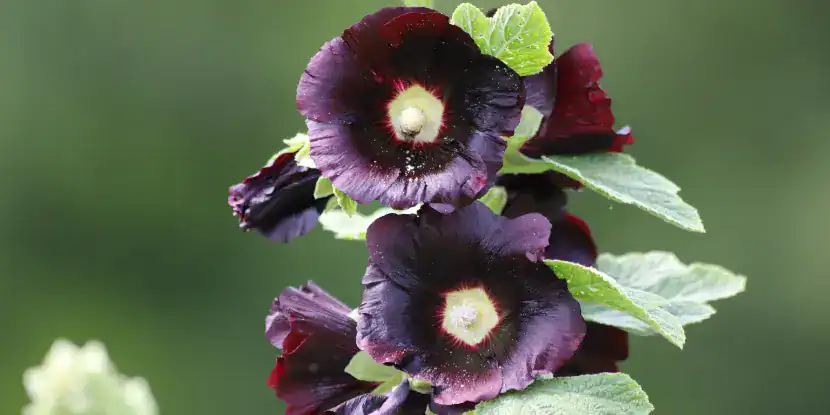
Are you bored with the same old pink flowers? Try purple so deep it’s almost black.
FAQs: Growing Hollyhocks
Q: Are hollyhocks drought-tolerant?
Once established, hollyhocks are highly drought-tolerant and ideal for water-conscious gardens.
Q: How tall do hollyhocks grow?
Hollyhocks can reach impressive heights of 6–8 feet, creating a stunning vertical display.
Q: Do hollyhocks bloom in their first year?
Most hollyhocks bloom in their second year, though some perennial varieties may flower in year one.
Q: Can I grow hollyhocks in pots?
Yes, but ensure the pot is large and deep to accommodate their extensive root systems.

Closeup of pink hollyhocks blossoms.
Q: How do I prevent rust on hollyhocks?
Choose well-spaced planting locations with good air circulation and promptly remove infected leaves.
Q: When is the best time to plant hollyhocks in LA?
Fall is ideal, as seeds will sprout in cooler weather and bloom the following spring.
Q: Are hollyhocks pollinator-friendly?
Yes. Hollyhocks attract bees, butterflies, and hummingbirds, making them a standout in eco-friendly gardens.
Q: Do hollyhocks come back every year?
Depending on the variety, hollyhocks often reseed themselves and return annually.

